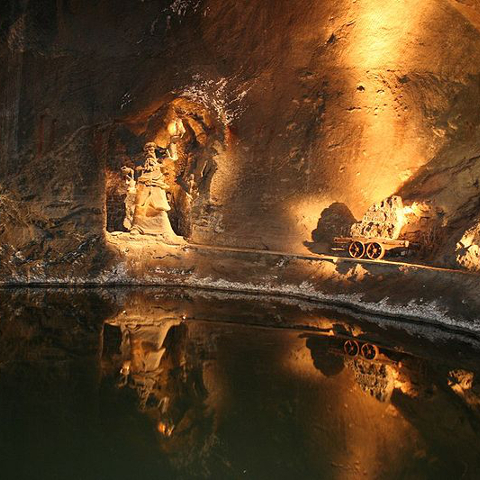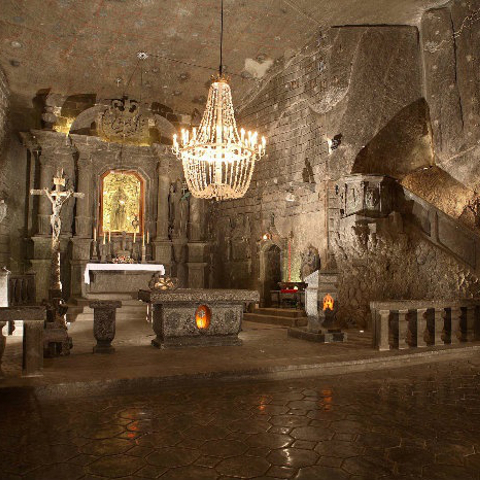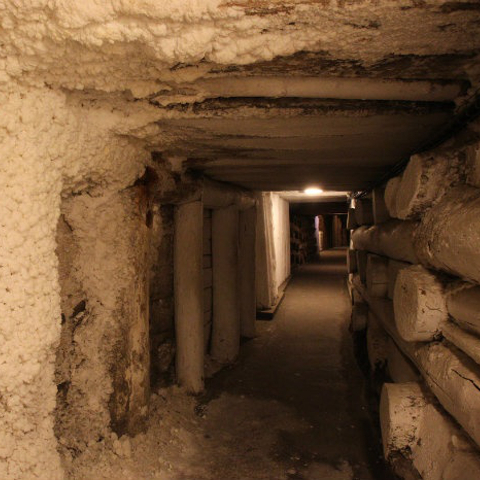Composers / Fryderyk Chopin / Places catalog
Wieliczka
Salt has been extracted in Wieliczka since the ninth century. At first, it was distilled from naturally salty springs. Rock salt deposits were discovered in the middle of the thirteenth century and began to be extracted using the deep mining method. Salt mining was a mainstay of the Polish economy for many centuries (during the fourteenth century, it accounted for a third of the crown revenue). The Wieliczka and Bochnia salt mines together comprised the Krakow Salt Works, which functioned from the thirteenth century until the First Partition of Poland (1772). Opened to the public in the sixteenth century, Wieliczka has become an increasingly popular sightseeing destination – a place where a ‘journey to the centre of the earth’ is really possible. Today’s sightseeing route was laid out at the turn of the nineteenth century.
By the early nineteenth century, the Wieliczka salt mine was already a popular stop on any Lesser Poland tourist itinerary, and in Chopin’s day a horse-drawn carriage could cover the 15 km from Krakow in an hour. No doubt having heard wondrous tales of salty grottos, the young Chopin, who was stopping over in Krakow in 1829, decided to embark on a subterranean outing. The visitors' book, introduced in 1774, records Chopin and his companions (Maciejewski, Hube, Brandt and Potocki) visiting the mine on 23 July 1829. Unfortunately, Chopin’s written accounts have not survived. One of those lost letters might have contained his impressions of the visit.
A tour of the mine took around two hours. Tourists were initially asked to don white, linen garments, similar to surplices, to protect their clothes from the salt. Any visitors who passed up the opportunity of going down the stairs were lowered 64.5 m underground by a huge hoist. The guides carried torches to light up the underground cellars. Visitors were shown halls and grottos and crossed an underground lake in a boat. They stopped a little longer at the Chapel of St Kinga, the consort of Duke Boleslaus the Chaste (1226–1279) and patron saint of the Wieliczka miners. Legend has it that the mine was discovered during the search for a ring that Kinga had dropped on the ground. Chopin would have been able to observe the miners at work, as salt was still being extracted there in his day. The miners chipped away chunks of salt using rudimentary tools and loaded it into barrels, which were then winched up to the surface.
The Krakow Salt Works Museum in Wieliczka opened at the mine in 1951 and began staging exhibitions under and above ground. The underground part of the Museum is 135 m below the surface. The tourist route is approx. 3 km long and consists of twenty chambers. This is a unique natural history museum on a worldwide scale. One can see how salt has been extracted from the Middle Ages to the present day. The Saltworks Castle is above ground. This was the salt works management office from the end of the thirteenth century until 1945. The courtyard boasts the oldest mineshaft (mid thirteenth century) in Poland, a fourteenth-century tower and the remains of the fourteenth-century defensive walls. The castle was renovated in 1976–1996 and is now used exclusively for museum purposes. Given their international significance, in 1978, the museum and the mine were placed on the UNESCO list of World Heritage Sites. The Saltworks Castle was added in 2013.
The museum archives contain the visitors' book, and reproductions of its pages are on display. The signatures include those of many prominent figures, including Ignacy Paderewski, Karol Wojtyła (Pope John Paul II), Józef Piłsudski, Johann Wolfgang von Goethe, Jan Matejko and Fryderyk Chopin.
On 9 October 2010, a bronze sculpture of Chopin by Bronisław Chromy was unveiled in the Maria Theresa III Chamber (part of the Krakow Salt Works Museum) in the underground cellars of the Wieliczka Salt Mine.
It is worth noting that the Krakow Salt Works (i.e. the Wieliczka and Bochnia mines) are the only mines in the world that have operated continuously from the Middle Ages to modern times.
-

Wieliczka. Phot. Marek Czerwiński. (creative commons)
-

Wieliczka. Phot. Wieliczka Salt Mine.
-

Wieliczka. Phot. Wieliczka Salt Mine.
-

Wieliczka. Phot. Wieliczka Salt Mine.